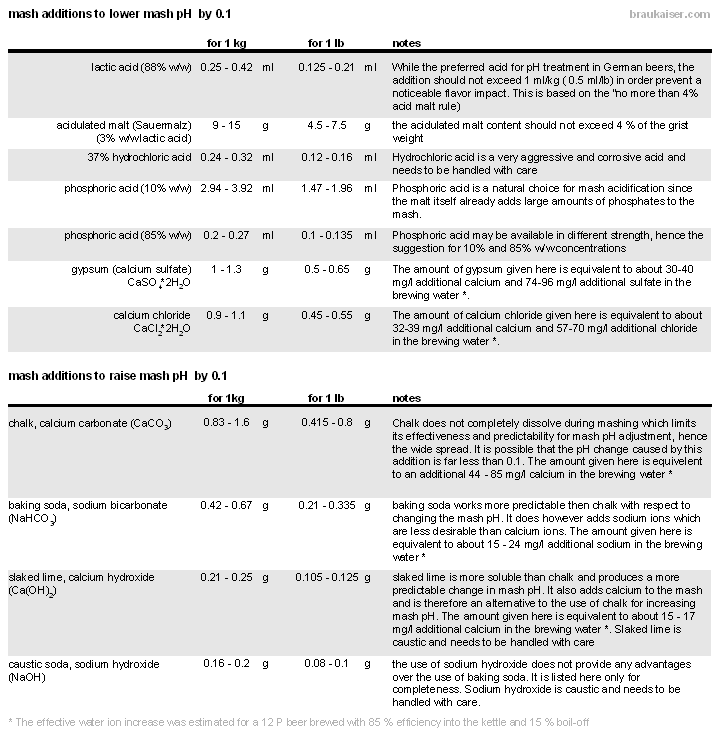Thanks for your further input/comments
The SN practice of adjusting all the water that comes into the brewery to pH 5.5 from what I have read is for a number of reasons
- Corrosion control - Boilers - Pipes etc
- Water discharge requirements to meet certain environmental requirements
- Sparge water and
- Something to do with Mash liquid
Nothing I have read/researched indicates what else SN do with the pH 5.5 water being used in the mash. They may use a high percentage of Acid Malt in the grain bill or they may use more Phosphoric Acid to trim the mash after Dough-In. I don't know and have been unable to find out and not that it is important just interesting
I understand that adjusting my mash water to say pH 5.5 prior to Dough-In may/will not result in my mash being at target say pH 5.2 - 5.3
I understand what you experienced with your water by adding however much Lactic Acid you added prior to Dough-In and from what I understand Melbourne water generally is very soft where as mine according to Bru'n has a calculated residual alkalinity of 53 which will have to be treated and if you consider what AJ deLange had to say in the above reference if you adjust your brew water to pH 5.5 then no further adjustment should be necessary to counter the remaining small amount of residual alkalinity as indicated in the following copied from that reference
I acknowledge that the example here is for a starting alkalinity of 76ppm where as mine is less than that at 53 so may not require as much Phos acid but I interpret the the outcome to be very similar - Maybe I am missing the boat totally and my next brew will/should set me straight on the matter.
Example
It has been reported that Sierra Nevada, consistent with the idea given here, treats all it's water to pH 5.5 with phosphoric acid. Chico water has average alkalinity of 76 ppm as calcium carbonate and pH which can be as low as 6.5 or as high as 7.9. Calcium content is 25 mg/L.
The chart below indicates what the effects of this may be. The curves plot the alkalinity that remains when water with alkalinity of 100 ppm as CaCO3 and pH as given on the horizontal axis is treated with acid until the pH reaches the value which corresponds to the particular curve as indicated in the legend. Solid curves with open symbols represent treatment with phosphoric acid and curves just below them in the same color represent sulfuric acid (or any other strong acid though the calculations were done for sulfuric - note that lactic acid could be considered strong in this application). Let's assume that SN measures pH of 7.2 (right in the middle of the range) on a given brew day and wants to acidify to pH 5.5 with a strong acid (sulfuric, hydrochloric, lactic or a blend of these). The 5.5 pH curves are red. The thin solid curve is the strong acid curve. Entering the chart on the bottom axis at pH 7.2 and reading up we see that were the alkalinity 100 the alkalinity remaining would be about 15 and conclude from this that the amount of alkalinity remaining for an actual alkalinity of 76 would be 15% of 76 or 11.4 ppm as CaCO3.

If mashing at pH 5.5 the alkalinity of the water has been satisfactorily dealt with. No additional acid will be needed to overcome the remaining alkalinity. Remember that alkalinity is measured by titrating to an end point pH of 4.5 or so. Were we to titrate from 5.5 to 4.5 we would indeed need extra acid in amount equal to 11.4/50 mEq/L.
So based on this example the remaining alkalinity in my brew water which started at 53 would now be something like 15% of 53 which equals about 8 and therefore not something to have to worry about
Cheers
Wobbly






